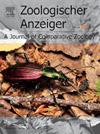伊朗白齿鼩(Crocidura属)多样性:分子证据和分类学意义
IF 1.5
3区 生物学
Q2 ZOOLOGY
引用次数: 0
摘要
白齿鼩鼱(白齿鼩属)广泛分布在古北地区,是伊朗不太为人所知的小型哺乳动物之一。近年来的分子研究揭示了传统名义种内部存在的一些深层差异,对其分类地位提出了挑战。收集了来自伊朗各地的标本,利用形态学和分子数据探索小白牙鼩鼱(Crocidura suaveolens)和双色鼩鼱(Crocidura leucodon)的多样性和分类学。线粒体细胞色素b (Cytb)分析确定了五个不同的谱系,其中两个是伊朗特有的。伊朗双色鼩(Crocidura persica Thomas, 1907)的具体位置得到形态学和遗传学(Cytb和Brca1)证据的支持。将长纹小棉棉虫的3个支系分为窄纹小棉棉虫、长纹小棉棉虫和长纹小棉棉虫;第一个种还包含来自Dasht-Bujnurd的序列,这是Crocidura gmelini的模式所在地。来自伊朗中部的一个未命名的谱系(谱系VIII)被描述为一个新物种,Crocidura darvishi n. sp.三个suaveolens类群物种在Cytb序列上明显不同,但在核Brca1树中差异较小。形态差异也很小。这些发现,连同伊朗物种的分类附件,增强了我们对伊朗独特动物群的了解。尽管伊朗在温带生物群中处于外围位置,但它是小型哺乳动物基系的热点地区,特别是在Hyrcanian Forest (C. persica, C. caspica)、Zagros (C. darvishi n. sp.)和Kopet-Dagh等保护区。本文章由计算机程序翻译,如有差异,请以英文原文为准。
White-toothed shrew (genus Crocidura) diversity in Iran: Molecular evidence and taxonomic implications
White-toothed shrews (genus Crocidura), with a wide distribution across the Palearctic, are among the lesser-known small mammals in Iran. Recent molecular studies uncovered several deep divergences within traditional nominal species, challenging their taxonomic status. Specimens from across Iran were collected to explore the diversity and taxonomy of the small white-toothed shrew (Crocidura suaveolens) and the bicoloured shrew (Crocidura leucodon) using both morphological and molecular data. Mitochondrial cytochrome b (Cytb) analysis identified five distinct lineages, two of which are endemic to Iran. The specific position of the Iranian bicoloured shrew (Crocidura persica Thomas, 1907) is supported by morphological and genetic (Cytb and Brca1) evidence. Three lineages of C. suaveolens sensu lato were classified as C. suaveolens sensu stricto, Crocidura gueldenstaedtii and Crocidura caspica; the first species also contains sequences from Dasht-Bujnurd which is the type locality of Crocidura gmelini. An unnamed lineage from central Iran (lineage VIII) is described as a new species, Crocidura darvishi n. sp. The three suaveolens group species clearly differ in Cytb sequences but less so in the nuclear Brca1 tree. Morphological differences are also slight. These findings, along with a taxonomic annex of Iranian species, enhance our understanding of Iran's unique fauna. Despite its peripheral location in temperate biotas, Iran is a hotspot for basal lineages of small mammals, especially in refugial areas like the Hyrcanian Forest (C. persica, C. caspica), Zagros (C. darvishi n. sp.), and Kopet-Dagh.
求助全文
通过发布文献求助,成功后即可免费获取论文全文。
去求助
来源期刊

Zoologischer Anzeiger
生物-动物学
CiteScore
2.80
自引率
7.10%
发文量
75
审稿时长
>12 weeks
期刊介绍:
Zoologischer Anzeiger - A Journal of Comparative Zoology is devoted to comparative zoology with a special emphasis on morphology, systematics, biogeography, and evolutionary biology targeting all metazoans, both modern and extinct. We also consider taxonomic submissions addressing a broader systematic and/or evolutionary context. The overall aim of the journal is to contribute to our understanding of the organismic world from an evolutionary perspective.
The journal Zoologischer Anzeiger invites suggestions for special issues. Interested parties may contact one of the editors.
 求助内容:
求助内容: 应助结果提醒方式:
应助结果提醒方式:


